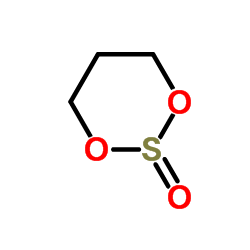1,3,2-Dioxathiane 2-oxide

1,3,2-Dioxathiane 2-oxide structure
|
Common Name | 1,3,2-Dioxathiane 2-oxide | ||
|---|---|---|---|---|
| CAS Number | 4176-55-0 | Molecular Weight | 122.143 | |
| Density | 1.5±0.1 g/cm3 | Boiling Point | 187.5±9.0 °C at 760 mmHg | |
| Molecular Formula | C3H6O3S | Melting Point | -14 °C | |
| MSDS | Chinese USA | Flash Point | 67.2±18.7 °C | |
| Symbol |


GHS05, GHS07 |
Signal Word | Danger | |
|
25-O-acetyl-23,24-dihydro-cucurbitacin F induces cell cycle G2/M arrest and apoptosis in human soft tissue sarcoma cells.
J. Ethnopharmacol. 164 , 265-72, (2015) Quisqualis indica is used in traditional Chinese medicine to treat cancer and related syndromes and also known for its anthelminthic effects.Soft tissue sarcomas represent a rare group of malignant tumors that frequently exhibit chemotherapeutic resistance an... |
|
|
Novel role for TRPC4 in regulation of macroautophagy by a small molecule in vascular endothelial cells.
Biochim. Biophys. Acta 1853(2) , 377-87, (2015) Macroautophagy (autophagy) is an important factor affecting the function of vascular endothelial cells (VECs) and must be tightly regulated in these cells. However, the precise mechanisms underlying this process, particularly in the presence of serum, remain ... |
|
|
Reductive opening of carbohydrate phenylsulfonylethylidene (PSE) acetals.
Carbohydr. Res. 417 , 117-24, (2015) The phenylsulfonylethylidene (PSE) acetal is a relatively new protecting group in carbohydrate chemistry. However, carbohydrate-derived phenylsulfonylethylidene (PSE) acetals show a different behavior in reductive desulfonylation than simple symmetrical aceta... |
|
|
A novel 2,5-diaminopyrimidine-based affinity probe for Bruton's tyrosine kinase.
Sci. Rep. 5 , 16136, (2015) As a critical regulator of the B-cell receptor signaling pathway, Bruton's tyrosine kinase (Btk) has attracted intensive drug discovery efforts for treating B-cell lineage cancers and autoimmune disorders. In particular, covalent inhibitors targeting Cys481 i... |
|
|
Construction of RNA-Quantum Dot Chimera for Nanoscale Resistive Biomemory Application.
ACS Nano 9 , 6675-82, (2015) RNA nanotechnology offers advantages to construct thermally and chemically stable nanoparticles with well-defined shape and structure. Here we report the development of an RNA-QD (quantum dot) chimera for resistive biomolecular memory application. Each QD hol... |
|
|
Dipeptidyl peptidase-IV inhibitory activity of dimeric dihydrochalcone glycosides from flowers of Helichrysum arenarium.
J. Nat. Med. 69 , 494-506, (2015) A methanol extract of everlasting flowers of Helichrysum arenarium L. Moench (Asteraceae) was found to inhibit the increase in blood glucose elevation in sucrose-loaded mice at 500 mg/kg p.o. The methanol extract also inhibited the enzymatic activity against ... |
|
|
New steroidal saponins and antiulcer activity from Solanum paniculatum L.
Food Chem. 186 , 160-7, (2015) Solanum paniculatum L. (Solanaceae) is a plant species widespread throughout tropical America, especially in the Brazilian Savanna region. It is used in Brazil for culinary purposes and in folk medicine to treat liver and gastric dysfunctions, as well as hang... |
|
|
Tuning the basicity of cyano-containing ionic liquids to improve SO2 capture through cyano-sulfur interactions.
Chemistry 21(14) , 5632-9, (2015) A new approach has been developed to improve SO2 sorption by cyano-containing ionic liquids (ILs) through tuning the basicity of ILs and cyano-sulfur interaction. Several kinds of cyano-containing ILs with different basicity were designed, prepared, and used ... |
|
|
Determination of monomeric composition in polyhydroxyalkanoates by liquid chromatography coupled with on-line mass spectrometry and off-line nuclear magnetic resonance.
Talanta 146 , 107-13, (2015) Polyhydroxyalkanoates (PHAs) are commercially-valuable biocompatible and biodegradable polymers with many potential medical, pharmaceutical and other industrial applications. The analysis of PHA monomeric composition is especially challenging due to the broad... |
|
|
Isolation of antifungal compound from Paeonia suffruticosa and its antifungal mechanism.
Chin. J. Integr. Med. 21(3) , 211-6, (2015) To isolate antifungal compound from Paeonia suffruticosa, and to find the antifungal mechanisms by observing the ultrastructural modifications of yeasts in growth phase produced by 1,2,3,4,6-penta-O-galloyl-beta-D-glucose (PGG).Peony (Paeonia suffruticosa) ro... |